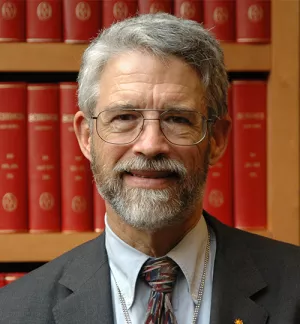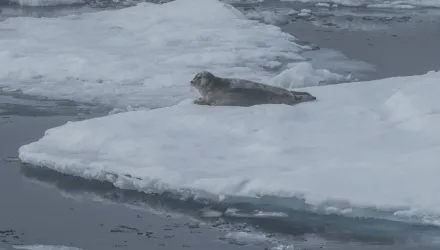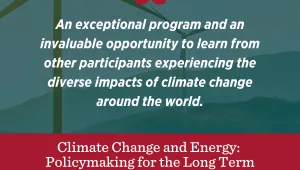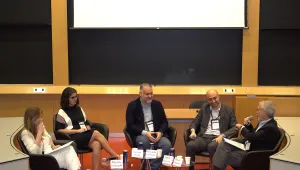
“Our real aim should be not simply to limit the amount of climate change that occurs (mitigation), but also to reduce the actual harm to society and to ecosystems from the changes in climate that can no longer be avoided (adaptation). Limiting the harm overall will require enormous efforts in both mitigation and adaptation, all around the world.”
–John P. Holdren
As numerous studies have made strikingly clear, climate change is increasing much more rapidly than anticipated and its negative impacts are becoming more and more visible around the world. From the escalating extremity of weather events, severe droughts and wildfires, to melting glaciers, rising sea levels, and disastrous floods, climate change is already harming humans and our ecosystems in a myriad of ways.
We asked several of our climate experts for their thoughts on how best to tackle our climate crisis. John P. Holdren, Henry Lee, Robert N. Stavins, Afreen Siddiqi, Kelly Sims Gallagher, and Halla Logadóttir respond below.
What would be sensible targets for and key ingredients of national and global strategies for addressing the climate change challenge?
John P. Holdren, Co-Director, Science, Technology, and Public Policy Program; former Assistant to President Obama for Science and Technology
“The best that can be hoped for is stabilizing Earth’s temperature at 1.5-2.0oC above the pre-industrial level before the end of the current century. That must be our goal. Achieving it will require: (1) initiating immediately, and sustaining for decades, deep cuts in CO emissions from the world’s energy, agricultural, and forestry enterprises, along with cuts in emissions of the other major heat-trapping gases and black soot; and (2) launching efforts worldwide to build resilience against the changes in climate that can no longer be avoided (adaptation). Success in these efforts will depend on imposing a significant price on carbon emissions, worldwide; on large increases in R&D to lower the costs of zero-emitting technologies and adaptation measures; and substantial assistance from developed countries to developing ones.”
________________________________________
What advances in the technologies of energy supply and use are most needed to cope with the climate change challenge?
Henry Lee, Director, Environment and Natural Resources Program
“Energy patterns in a world constrained by climate change will rely increasingly on electricity, not only to power our buildings, but also to run our cars, heat our homes, and fuel our industrial processes. While individual technologies, such as better storage options, more efficient heat pumps, new ways to make cement or steel and improved electric vehicles will all make a difference, the most imposing challenge is to integrate all of these into a more flexible electric system shaped by regulation characterized more by markets and pricing than by rigid constraints and outdated command and control regimes. The former will provide incentives to both energy consumers and producers as well as hundreds of inventors and innovators who will expand the energy portfolio of the future.”
______________________________________
What are the opportunities and challenges of carbon-pricing as an element of U.S. climate strategy?
Robert N. Stavins, Director, Harvard Project on Climate Agreements
“There are three reasons most U.S. policy analysts favor carbon-pricing—carbon taxes or carbon cap-and-trade systems. First, given that the sources of carbon dioxide (CO2) emissions number in the hundreds of millions, it is inconceivable that emissions could be effectively regulated through conventional technology or performance standards. But decentralized price signals can affect all sources in proportion to their relative carbon intensity. Second, carbon-pricing mechanisms can achieve targets at the least cost by providing incentives for all sources to control at the same marginal abatement cost. Third, carbon-pricing can provide effective incentives for carbon-friendly technological innovation. But because other market failures can get in the way of price signals in particular applications, economists recognize that carbon-pricing will not be sufficient. In specific cases, appropriate complementary policies will also be required.”
__________________________________________
What is most needed to limit the harm from climate change to developing countries?
Afreen Siddiqi, Visiting Scholar, Science, Technology, and Public Policy Program
“Developing countries need adaptation capacity to limit the harm from climate change. In particular, their systems of food and water should receive high priority. Agriculture is of significant socio-economic importance in developing countries, and in some cases, it constitutes a large fraction of national GDP and contributes to livelihoods for millions. It is also the largest water-consuming sector in most countries. A twin focus on adaptation of agriculture and water management is critical with an eye towards not only mitigating risks (such as crop failures or floods) but also potentially harnessing new opportunities (such as production of new types of crops or multi-season production). This will require a trio of use of new technologies, development of infrastructure, and synergistic policies.”
________________________________________
How should we think about China’s role in addressing global climate change?
Kelly Gallagher, Belfer Center Board of Directors; Professor of Energy and Environmental Policy, Fletcher School, Tufts University
“China is intrinsically important to solving the climate challenge as the largest global emitter, but it is also symbolically important as a leader in the global arena. When President Trump announced he intended to withdraw the United States from the Paris Agreement, President Xi responded with a speech where he said, 'All parties should work together to implement the Paris agreement. China will continue to take steps to tackle climate change and fully honor its obligations.' Together with the U.S., China paved the way for the Paris Agreement by announcing its targets early, inspiring many other developing countries to do so as well. China also appears to be on track to achieve its Paris targets early. The main challenge for China today is to green its Belt and Road Initiative so it does not become a conduit for polluting investments in other developing countries.”
______________________________________
What is most needed to address the challenges arising from climate change in the Arctic?
Halla Hrund Logadóttir, Co-Director, Arctic Initiative; former Director, Iceland School of Energy, Reykjavik University
“Tackling the many challenges arising from climate change in the rapidly transforming Arctic requires creating and implementing new and innovative science-based policies. Effective collaboration between countries, sectors, experts, disciplines and communities, with the goal of conserving ecosystems while ensuring sustainable development, is a key ingredient for success here. To support that process, it’s critical that we boost research and global education on what a ‘climate changed’ Arctic actually means for people and our planet. Without such understanding, people inside and outside the Arctic are less likely to care and effectively push forward the policies that can help avoid unnecessary environmental, geopolitical, and economic risks in the future.”
_________________________________________
See more from these and other climate experts here.
"Acting on the Climate Crisis: What Must We Do Now?" Belfer Center Newsletter. Belfer Center for Science and International Affairs, Harvard Kennedy School (Summer 2019).















